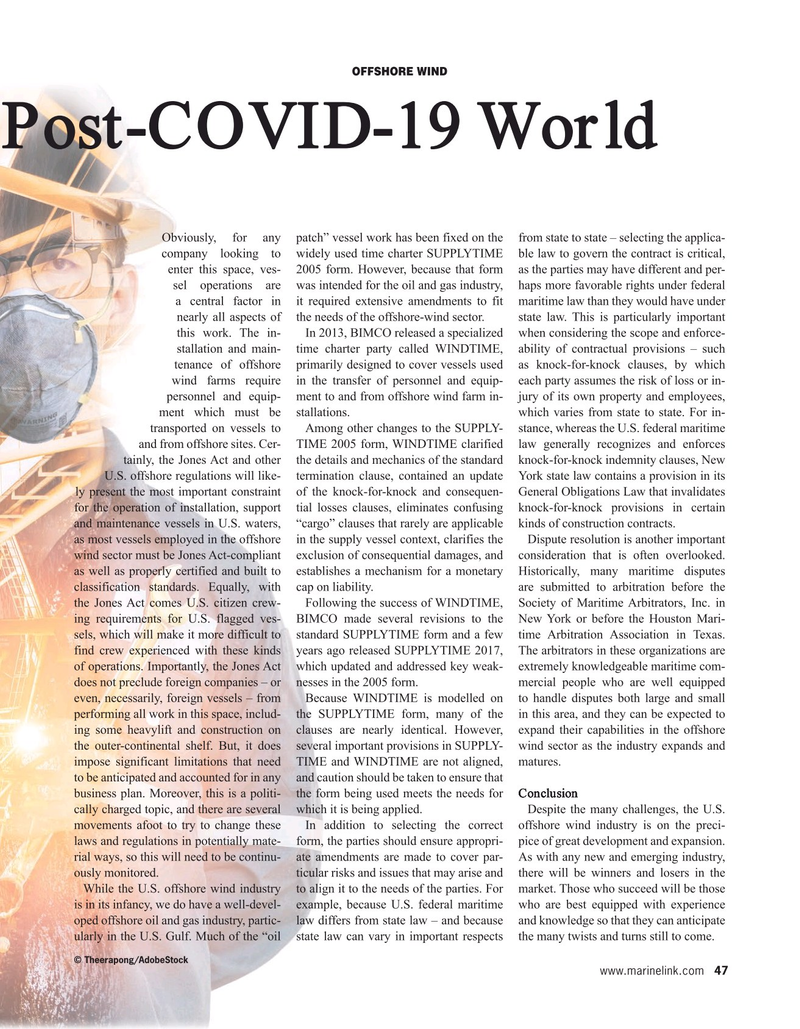
Page 47: of Maritime Reporter Magazine (June 2020)
2020 Yearbook
Read this page in Pdf, Flash or Html5 edition of June 2020 Maritime Reporter Magazine
OffshOre wind
U.S. Offshore Wind in a Post-COVID-19 World
Obviously, for any patch” vessel work has been fixed on the from state to state – selecting the applica- company looking to widely used time charter SUPPLYTIME ble law to govern the contract is critical, enter this space, ves- 2005 form. However, because that form as the parties may have different and per- sel operations are was intended for the oil and gas industry, haps more favorable rights under federal a central factor in it required extensive amendments to fit maritime law than they would have under nearly all aspects of the needs of the offshore-wind sector. state law. This is particularly important this work. The in- In 2013, BIMCO released a specialized when considering the scope and enforce- stallation and main- time charter party called WINDTIME, ability of contractual provisions – such tenance of offshore primarily designed to cover vessels used as knock-for-knock clauses, by which wind farms require in the transfer of personnel and equip- each party assumes the risk of loss or in- personnel and equip- ment to and from offshore wind farm in- jury of its own property and employees, ment which must be stallations. which varies from state to state. For in- transported on vessels to Among other changes to the SUPPLY- stance, whereas the U.S. federal maritime and from offshore sites. Cer- TIME 2005 form, WINDTIME clarified law generally recognizes and enforces tainly, the Jones Act and other the details and mechanics of the standard knock-for-knock indemnity clauses, New
U.S. offshore regulations will like- termination clause, contained an update York state law contains a provision in its ly present the most important constraint of the knock-for-knock and consequen- General Obligations Law that invalidates for the operation of installation, support tial losses clauses, eliminates confusing knock-for-knock provisions in certain and maintenance vessels in U.S. waters, “cargo” clauses that rarely are applicable kinds of construction contracts.
as most vessels employed in the offshore in the supply vessel context, clarifies the Dispute resolution is another important wind sector must be Jones Act-compliant exclusion of consequential damages, and consideration that is often overlooked. as well as properly certified and built to establishes a mechanism for a monetary Historically, many maritime disputes classification standards. Equally, with cap on liability. are submitted to arbitration before the the Jones Act comes U.S. citizen crew- Following the success of WINDTIME, Society of Maritime Arbitrators, Inc. in ing requirements for U.S. flagged ves- BIMCO made several revisions to the New York or before the Houston Mari- sels, which will make it more difficult to standard SUPPLYTIME form and a few time Arbitration Association in Texas. find crew experienced with these kinds years ago released SUPPLYTIME 2017, The arbitrators in these organizations are of operations. Importantly, the Jones Act which updated and addressed key weak- extremely knowledgeable maritime com- does not preclude foreign companies – or nesses in the 2005 form. mercial people who are well equipped even, necessarily, foreign vessels – from Because WINDTIME is modelled on to handle disputes both large and small performing all work in this space, includ- the SUPPLYTIME form, many of the in this area, and they can be expected to ing some heavylift and construction on clauses are nearly identical. However, expand their capabilities in the offshore the outer-continental shelf. But, it does several important provisions in SUPPLY- wind sector as the industry expands and impose significant limitations that need TIME and WINDTIME are not aligned, matures.
to be anticipated and accounted for in any and caution should be taken to ensure that business plan. Moreover, this is a politi- the form being used meets the needs for Conclusion cally charged topic, and there are several which it is being applied. Despite the many challenges, the U.S. movements afoot to try to change these In addition to selecting the correct offshore wind industry is on the preci- laws and regulations in potentially mate- form, the parties should ensure appropri- pice of great development and expansion. rial ways, so this will need to be continu- ate amendments are made to cover par- As with any new and emerging industry, ously monitored. ticular risks and issues that may arise and there will be winners and losers in the
While the U.S. offshore wind industry to align it to the needs of the parties. For market. Those who succeed will be those is in its infancy, we do have a well-devel- example, because U.S. federal maritime who are best equipped with experience oped offshore oil and gas industry, partic- law differs from state law – and because and knowledge so that they can anticipate ularly in the U.S. Gulf. Much of the “oil state law can vary in important respects the many twists and turns still to come.
© Theerapong/AdobeStock www.marinelink.com 47

 46
46

 48
48
